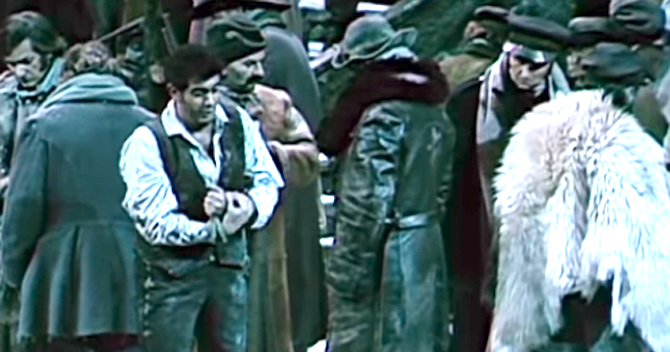 Facebook
Facebook
 X
X
 Instagram
Instagram
 TikTok
TikTok
 Youtube
Youtube

I’m spending some time in the Santa Cruz mountains and a redwood forest. A redwood forest is often compared to a cathedral and for good reason. I must admit there is something of a sacred quietude that combines with the soaring trees creating a cathedral-esque atmosphere.
The music of the late Renaissance and early Baroque fits the forest perfectly. If they could sing, the trees would probably prefer Palestrina.
I did begin to wonder if there was any music inspired by the redwoods. I should qualify that. I began to wonder if there was any good music inspired by the redwoods. I’m sure there is some “innovative” composition which tries hard to represent the redwoods as victims of the patriarchy.
I was thinking there might be something of substance such as Frederick Delius’s Florida Suite or Ferde Grofé’s Grand Canyon. The British have done a good job of immortalizing their countryside with pieces such as On the Banks of Green Willow by George Butterworth and In the Fen Country by Vaughan Williams. Of course, Beethoven and Mahler immortalized the Austrian countryside with their symphonic efforts.
The only thing, of substance, I came up with for the redwoods is Puccini’s Girl of the Golden West which is set in a redwood forest during the Gold Rush. Obviously the opera is not specifically about redwoods but it is an underappreciated masterpiece.
Plácido Domingo sings "Ch'ella mi creda libero e lontano" from the Puccini opera.
The opera is based on a play by David Belasco. Belasco was also the author of the play that inspired Puccini to write Madama Butterfly.
The character Minnie is the girl. She’s is a strong woman making her way in the Wild West. Minnie runs a saloon and gives the miners reading lessons. She is Puccini’s strongest heroine but doesn’t always get the respect she deserves. It could be because she falls in love with the wrong man.
Minnie is supposed to marry the upstanding sheriff but she’s not into him. Instead, she falls for Ramirez, the bandit masquerading as Dick Johnson. Minnie even cheats at cards to help Ramirez escape.
Ultimately Ramirez is captured. The miners decide to hang him but Minnie interrupts the execution and faces the mob down, holding them at gunpoint. She convinces the miners that they owe her for all the care she’s given them, and they allow Ramirez and her to leave and start a new life together.
Minnie combines qualities of care and compassion along with the willingness to wield a gun in defense of the man she loves. She is unique in opera. She is neither a victim nor temptress but a fully integrated character who owns her dark side and uses it when necessary.


I’m spending some time in the Santa Cruz mountains and a redwood forest. A redwood forest is often compared to a cathedral and for good reason. I must admit there is something of a sacred quietude that combines with the soaring trees creating a cathedral-esque atmosphere.
The music of the late Renaissance and early Baroque fits the forest perfectly. If they could sing, the trees would probably prefer Palestrina.
I did begin to wonder if there was any music inspired by the redwoods. I should qualify that. I began to wonder if there was any good music inspired by the redwoods. I’m sure there is some “innovative” composition which tries hard to represent the redwoods as victims of the patriarchy.
I was thinking there might be something of substance such as Frederick Delius’s Florida Suite or Ferde Grofé’s Grand Canyon. The British have done a good job of immortalizing their countryside with pieces such as On the Banks of Green Willow by George Butterworth and In the Fen Country by Vaughan Williams. Of course, Beethoven and Mahler immortalized the Austrian countryside with their symphonic efforts.
The only thing, of substance, I came up with for the redwoods is Puccini’s Girl of the Golden West which is set in a redwood forest during the Gold Rush. Obviously the opera is not specifically about redwoods but it is an underappreciated masterpiece.
Plácido Domingo sings "Ch'ella mi creda libero e lontano" from the Puccini opera.
The opera is based on a play by David Belasco. Belasco was also the author of the play that inspired Puccini to write Madama Butterfly.
The character Minnie is the girl. She’s is a strong woman making her way in the Wild West. Minnie runs a saloon and gives the miners reading lessons. She is Puccini’s strongest heroine but doesn’t always get the respect she deserves. It could be because she falls in love with the wrong man.
Minnie is supposed to marry the upstanding sheriff but she’s not into him. Instead, she falls for Ramirez, the bandit masquerading as Dick Johnson. Minnie even cheats at cards to help Ramirez escape.
Ultimately Ramirez is captured. The miners decide to hang him but Minnie interrupts the execution and faces the mob down, holding them at gunpoint. She convinces the miners that they owe her for all the care she’s given them, and they allow Ramirez and her to leave and start a new life together.
Minnie combines qualities of care and compassion along with the willingness to wield a gun in defense of the man she loves. She is unique in opera. She is neither a victim nor temptress but a fully integrated character who owns her dark side and uses it when necessary.
Comments